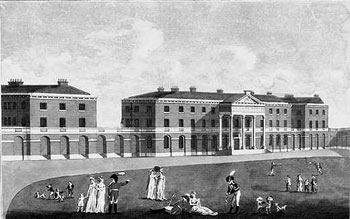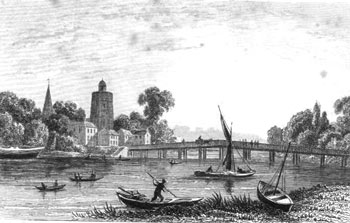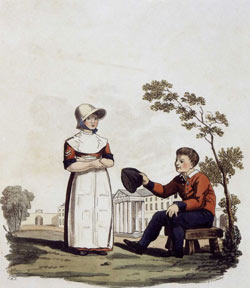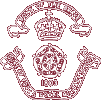The children of William and Ann Lane are of particular interest in the history of the Royal Military Asylum, for the circumstances of their admission are unusual. William Lane enlisted in the Ist Foot Guards (the Grenadier Guards) in 1793 and served in the Low Countries in 1795 under Frederick, Duke of York, during the first clash with revolutionary France. William and Ann Lane married about 1798 and three of their children were accepted in the RMA. Placement of three children in the institution is interesting for reasons discussed in this article.
The first child, Sybella (a variant of the Greek Sibyl or Sybil) was admitted at age 6 in 1804, a mere nine months after the Asylum opened its doors in August 1803. She is the earliest known entrant to the RMA to date for whom a descendant has claimed kinship. Her brothers, Alexander and Charles, born well after Sybella, were admitted in 1816 and 1817 respectively. [The passage of 13 years between the first and second entrants is also unusual. Siblings entering the Asylum were much nearer together in age.]
The Lanes had eight living children including twins born the year Sybella entered the RMA.

[A thought must be spared for the women of the early 19th century who, living as most were in poverty, were continually pregnant throughout their child-bearing years. Whether or not babies of the Lane line were stillborn is unknown.]
Considering the rules of entry that nominally gave preference first to orphans, then to partial orphans (that is having only one parent living) and the huge number of military orphans resulting from the Great War with France (1793-1815), admission of the Lane children is surprising. Both parents were alive when the children were admitted. This is not as strange as it at first seems given the preferential order of admissions. The question to answer is why?
What explains the admission of so many children from one family when countless military families were in desperate need of the Army's charity, especially those whose family heads had fallen in action? The answer probably lies in the influence the 1st Foot Guards had with the Board of Commissioners, which vetted the 'petitions for admission'.

The connections of the company officers of the Grenadier Guards with members of the Board and the Duke of York were close. They were able to exert an influence on right of entry that favoured the children of Grenadiers. Unlike other battalions of foot soldiers, the Ist Foot Guards were permanently quartered in London when not on active service, and guarding the monarch. There were during the 1793-1815 period three battalions of Ist Foot Guards, and all three served overseas at various times during the Wars. The Guards occupied their permanent quarters while stationed in the Home Command. In contrast, other units of infantry under orders from the Horse Guards moved from station to station.
Another factor favouring the Guards was that Frederick Duke of York was their Colonel-in-Chief. While he had little to do with the Regiment that was not ceremonial, he was the Regiment's titular head; also Commander-in-Chief of the Army and Chairman of the Board of Commissioners. So goes the maxim that it's not what you know, but who you know that counts.
Peter G, who is as familiar as anyone with the statistics of the School, confirms the circumstantial evidence of favouritism. From 29th August 1803 to 31 December 1815, he notes, there were 2890 admissions (girls and boys) for all regiments and corps of the regular army. To estimate an allocation of places for the Guards, a rough guide to allotment would be 2890/100, say 1 per cent for each unit or, numerically, 28 places.
The admission of three siblings of the Lane family does not surprise Howard Clarke.* He points out that in her doctoral dissertation, Dr Patricia Lin** took a sample of 662 of the 1991 boys admitted to the RMA during the 1803-1815 period. Of that number 8 per cent were complete orphans; 30% had deceased fathers;11% had mothers gone the way of all flesh; and just over 50 per cent had fathers who had been ordered on foreign service, or had other children to support. In short, it is not so much the fact that both Lane parents were alive as the large percentage of Grenadier Guards children admitted to the Asylum.

Howard Clarke also noted that the 1808 Hibernian School charter copied the order of preference for admissions from the RMA warrant. This says that "…preference shall in general be given to...." The Hibernian governors argued that this gave them discretion and there is certainly evidence that although they quickly admitted petitions on behalf of complete orphans, they favoured the children of soldiers of long service and good character. The wording of the RMA Warrants will most likely say that "The merit of the father as to regimental character shall always be considered a principal recommendation". This consideration together with the influence of the Guards with the Board suggests that William Lane had an exemplary service record.
A final observation is that the petitions for admission of the Lane boys are extant. Copies have been provided from the School records. The petition for Sybella Lane, however, has been lost. This is probably because entering the Asylum at age six, Sybella went directly to the 'infants orphanage' opened on the Isle of Wight in 1797 by General George Hewett. The infants orphanage became a part of the RMA when that institution was founded by royal warrant in 1801. Sybella would have stayed at the IOW institution to help take care of infant orphans until she was discharged to the care of her parents. At the start of the RMA, orphan infants as young as six months were taken into care.
* Author of the A New History of the Royal Hibernian Military School (1765-1924)
** Extending Her Arms: Military Families and the Transformation of the British State, 1793-1815, University of California, Berkeley, 1997


